Financial Accounting Principles and Practical Application Report
VerifiedAdded on 2023/01/06
|22
|4660
|22
Report
AI Summary
This report delves into the core principles of financial accounting, emphasizing its role in monitoring a business's financial activities. It begins by defining financial accounting and its purpose, highlighting the significance of financial reporting, including income statements and balance sheets. The report then explores both internal and external stakeholders of a large organization, explaining their interests in financial information. The practical section focuses on understanding the dual-entry accounting system and the preparation of final accounts, supported by examples from multiple clients. Key topics such as bank reconciliation statements and suspense accounts are also explained. The report provides detailed financial statements for several clients, including profit and loss statements, statements of changes in equity, and statements of financial position, along with supporting schedules and notes. The assignment concludes with a comprehensive overview of financial accounting's importance and its practical applications in business decision-making.

Financial Accounting
Paraphrase This Document
Need a fresh take? Get an instant paraphrase of this document with our AI Paraphraser

INTRODUCTION............2
MAIN BODY..................................................................................................................................2
TASK 1............................................................................................................................................2
1. Define financial accounting and its purpose............................................................................2
2. Explain two internal stakeholders and four external stakeholder of a large organization.......5
TASK 2............................................................................................................................................6
CLIENT 1........................................................................................................................................6
CLIENT 2......................................................................................................................................11
CLIENT 3......................................................................................................................................15
CLIENT 4......................................................................................................................................17
CLIENT 5......................................................................................................................................18
CONCLUSION..............................................................................................................................20
REFERENCES..............................................................................................................................21
1
MAIN BODY..................................................................................................................................2
TASK 1............................................................................................................................................2
1. Define financial accounting and its purpose............................................................................2
2. Explain two internal stakeholders and four external stakeholder of a large organization.......5
TASK 2............................................................................................................................................6
CLIENT 1........................................................................................................................................6
CLIENT 2......................................................................................................................................11
CLIENT 3......................................................................................................................................15
CLIENT 4......................................................................................................................................17
CLIENT 5......................................................................................................................................18
CONCLUSION..............................................................................................................................20
REFERENCES..............................................................................................................................21
1
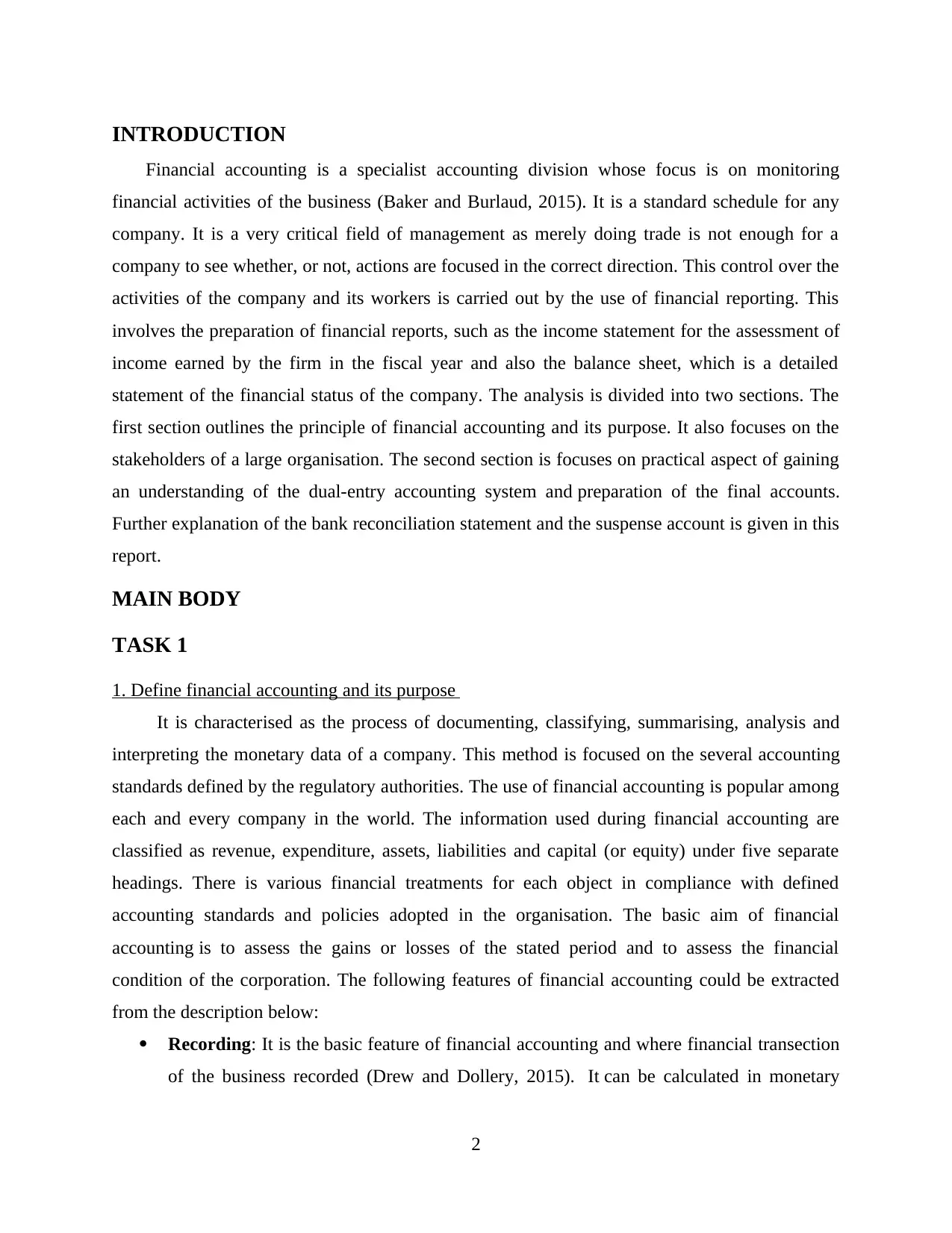
INTRODUCTION
Financial accounting is a specialist accounting division whose focus is on monitoring
financial activities of the business (Baker and Burlaud, 2015). It is a standard schedule for any
company. It is a very critical field of management as merely doing trade is not enough for a
company to see whether, or not, actions are focused in the correct direction. This control over the
activities of the company and its workers is carried out by the use of financial reporting. This
involves the preparation of financial reports, such as the income statement for the assessment of
income earned by the firm in the fiscal year and also the balance sheet, which is a detailed
statement of the financial status of the company. The analysis is divided into two sections. The
first section outlines the principle of financial accounting and its purpose. It also focuses on the
stakeholders of a large organisation. The second section is focuses on practical aspect of gaining
an understanding of the dual-entry accounting system and preparation of the final accounts.
Further explanation of the bank reconciliation statement and the suspense account is given in this
report.
MAIN BODY
TASK 1
1. Define financial accounting and its purpose
It is characterised as the process of documenting, classifying, summarising, analysis and
interpreting the monetary data of a company. This method is focused on the several accounting
standards defined by the regulatory authorities. The use of financial accounting is popular among
each and every company in the world. The information used during financial accounting are
classified as revenue, expenditure, assets, liabilities and capital (or equity) under five separate
headings. There is various financial treatments for each object in compliance with defined
accounting standards and policies adopted in the organisation. The basic aim of financial
accounting is to assess the gains or losses of the stated period and to assess the financial
condition of the corporation. The following features of financial accounting could be extracted
from the description below:
Recording: It is the basic feature of financial accounting and where financial transection
of the business recorded (Drew and Dollery, 2015). It can be calculated in monetary
2
Financial accounting is a specialist accounting division whose focus is on monitoring
financial activities of the business (Baker and Burlaud, 2015). It is a standard schedule for any
company. It is a very critical field of management as merely doing trade is not enough for a
company to see whether, or not, actions are focused in the correct direction. This control over the
activities of the company and its workers is carried out by the use of financial reporting. This
involves the preparation of financial reports, such as the income statement for the assessment of
income earned by the firm in the fiscal year and also the balance sheet, which is a detailed
statement of the financial status of the company. The analysis is divided into two sections. The
first section outlines the principle of financial accounting and its purpose. It also focuses on the
stakeholders of a large organisation. The second section is focuses on practical aspect of gaining
an understanding of the dual-entry accounting system and preparation of the final accounts.
Further explanation of the bank reconciliation statement and the suspense account is given in this
report.
MAIN BODY
TASK 1
1. Define financial accounting and its purpose
It is characterised as the process of documenting, classifying, summarising, analysis and
interpreting the monetary data of a company. This method is focused on the several accounting
standards defined by the regulatory authorities. The use of financial accounting is popular among
each and every company in the world. The information used during financial accounting are
classified as revenue, expenditure, assets, liabilities and capital (or equity) under five separate
headings. There is various financial treatments for each object in compliance with defined
accounting standards and policies adopted in the organisation. The basic aim of financial
accounting is to assess the gains or losses of the stated period and to assess the financial
condition of the corporation. The following features of financial accounting could be extracted
from the description below:
Recording: It is the basic feature of financial accounting and where financial transection
of the business recorded (Drew and Dollery, 2015). It can be calculated in monetary
2
⊘ This is a preview!⊘
Do you want full access?
Subscribe today to unlock all pages.

Trusted by 1+ million students worldwide
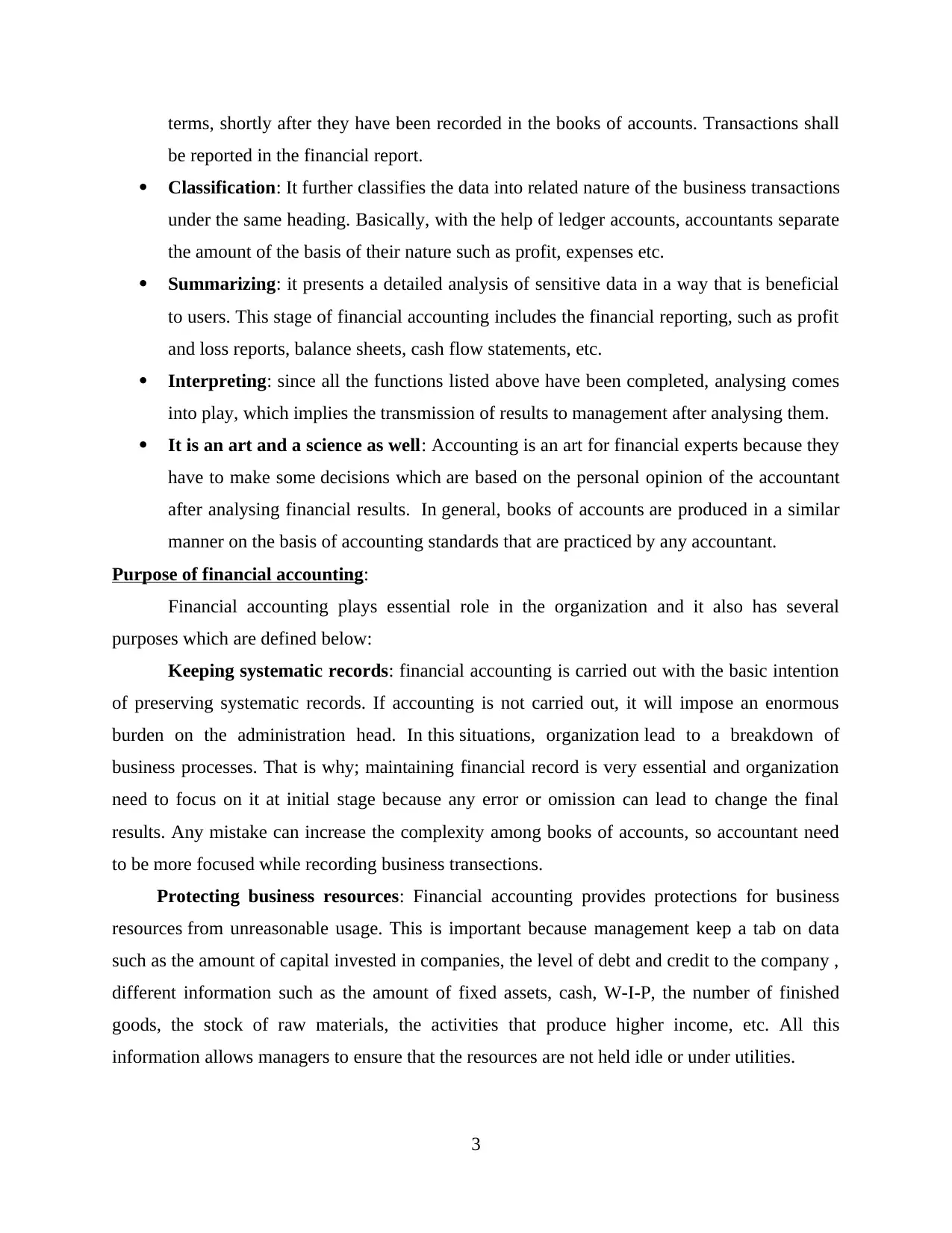
terms, shortly after they have been recorded in the books of accounts. Transactions shall
be reported in the financial report.
Classification: It further classifies the data into related nature of the business transactions
under the same heading. Basically, with the help of ledger accounts, accountants separate
the amount of the basis of their nature such as profit, expenses etc.
Summarizing: it presents a detailed analysis of sensitive data in a way that is beneficial
to users. This stage of financial accounting includes the financial reporting, such as profit
and loss reports, balance sheets, cash flow statements, etc.
Interpreting: since all the functions listed above have been completed, analysing comes
into play, which implies the transmission of results to management after analysing them.
It is an art and a science as well: Accounting is an art for financial experts because they
have to make some decisions which are based on the personal opinion of the accountant
after analysing financial results. In general, books of accounts are produced in a similar
manner on the basis of accounting standards that are practiced by any accountant.
Purpose of financial accounting:
Financial accounting plays essential role in the organization and it also has several
purposes which are defined below:
Keeping systematic records: financial accounting is carried out with the basic intention
of preserving systematic records. If accounting is not carried out, it will impose an enormous
burden on the administration head. In this situations, organization lead to a breakdown of
business processes. That is why; maintaining financial record is very essential and organization
need to focus on it at initial stage because any error or omission can lead to change the final
results. Any mistake can increase the complexity among books of accounts, so accountant need
to be more focused while recording business transections.
Protecting business resources: Financial accounting provides protections for business
resources from unreasonable usage. This is important because management keep a tab on data
such as the amount of capital invested in companies, the level of debt and credit to the company ,
different information such as the amount of fixed assets, cash, W-I-P, the number of finished
goods, the stock of raw materials, the activities that produce higher income, etc. All this
information allows managers to ensure that the resources are not held idle or under utilities.
3
be reported in the financial report.
Classification: It further classifies the data into related nature of the business transactions
under the same heading. Basically, with the help of ledger accounts, accountants separate
the amount of the basis of their nature such as profit, expenses etc.
Summarizing: it presents a detailed analysis of sensitive data in a way that is beneficial
to users. This stage of financial accounting includes the financial reporting, such as profit
and loss reports, balance sheets, cash flow statements, etc.
Interpreting: since all the functions listed above have been completed, analysing comes
into play, which implies the transmission of results to management after analysing them.
It is an art and a science as well: Accounting is an art for financial experts because they
have to make some decisions which are based on the personal opinion of the accountant
after analysing financial results. In general, books of accounts are produced in a similar
manner on the basis of accounting standards that are practiced by any accountant.
Purpose of financial accounting:
Financial accounting plays essential role in the organization and it also has several
purposes which are defined below:
Keeping systematic records: financial accounting is carried out with the basic intention
of preserving systematic records. If accounting is not carried out, it will impose an enormous
burden on the administration head. In this situations, organization lead to a breakdown of
business processes. That is why; maintaining financial record is very essential and organization
need to focus on it at initial stage because any error or omission can lead to change the final
results. Any mistake can increase the complexity among books of accounts, so accountant need
to be more focused while recording business transections.
Protecting business resources: Financial accounting provides protections for business
resources from unreasonable usage. This is important because management keep a tab on data
such as the amount of capital invested in companies, the level of debt and credit to the company ,
different information such as the amount of fixed assets, cash, W-I-P, the number of finished
goods, the stock of raw materials, the activities that produce higher income, etc. All this
information allows managers to ensure that the resources are not held idle or under utilities.
3
Paraphrase This Document
Need a fresh take? Get an instant paraphrase of this document with our AI Paraphraser
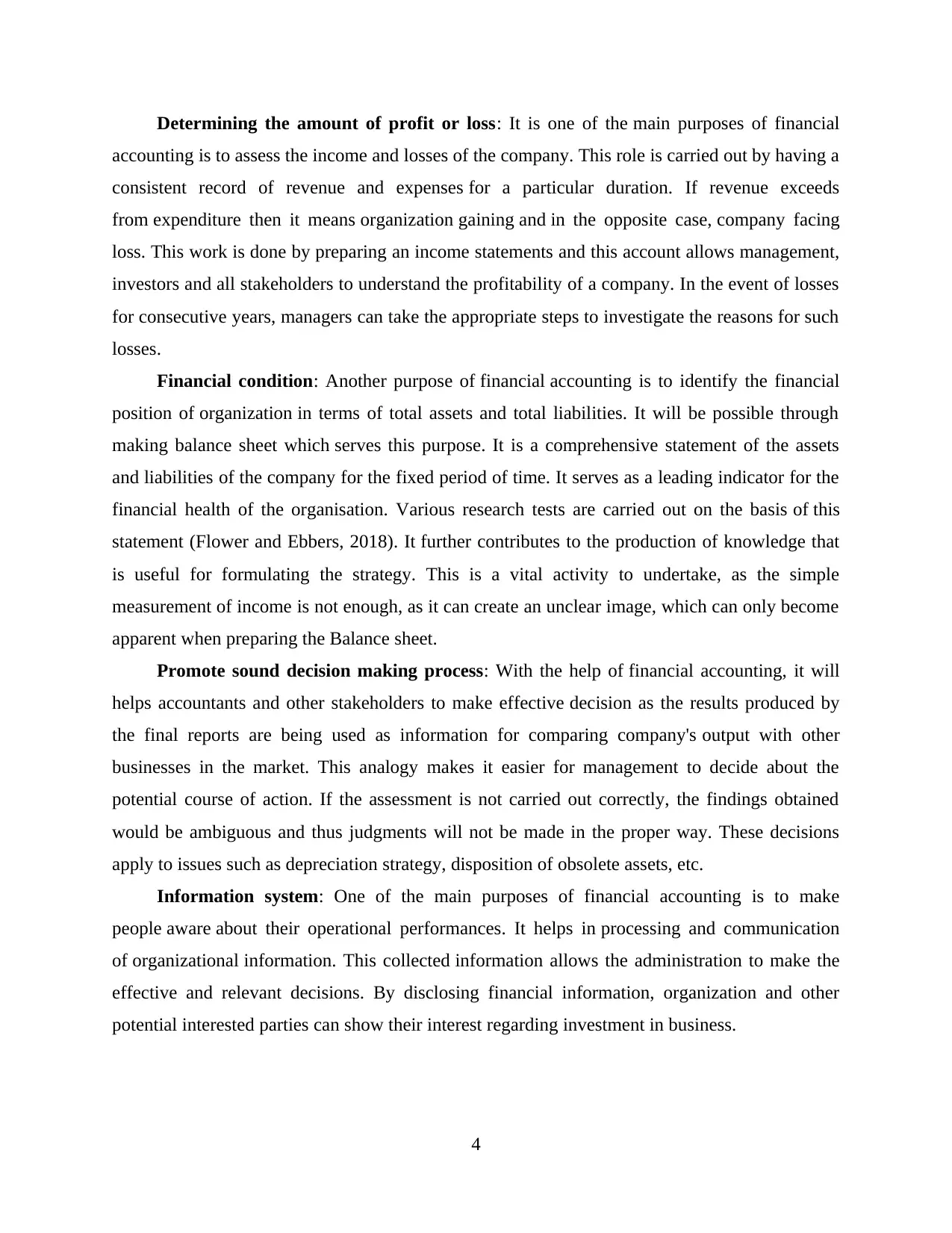
Determining the amount of profit or loss: It is one of the main purposes of financial
accounting is to assess the income and losses of the company. This role is carried out by having a
consistent record of revenue and expenses for a particular duration. If revenue exceeds
from expenditure then it means organization gaining and in the opposite case, company facing
loss. This work is done by preparing an income statements and this account allows management,
investors and all stakeholders to understand the profitability of a company. In the event of losses
for consecutive years, managers can take the appropriate steps to investigate the reasons for such
losses.
Financial condition: Another purpose of financial accounting is to identify the financial
position of organization in terms of total assets and total liabilities. It will be possible through
making balance sheet which serves this purpose. It is a comprehensive statement of the assets
and liabilities of the company for the fixed period of time. It serves as a leading indicator for the
financial health of the organisation. Various research tests are carried out on the basis of this
statement (Flower and Ebbers, 2018). It further contributes to the production of knowledge that
is useful for formulating the strategy. This is a vital activity to undertake, as the simple
measurement of income is not enough, as it can create an unclear image, which can only become
apparent when preparing the Balance sheet.
Promote sound decision making process: With the help of financial accounting, it will
helps accountants and other stakeholders to make effective decision as the results produced by
the final reports are being used as information for comparing company's output with other
businesses in the market. This analogy makes it easier for management to decide about the
potential course of action. If the assessment is not carried out correctly, the findings obtained
would be ambiguous and thus judgments will not be made in the proper way. These decisions
apply to issues such as depreciation strategy, disposition of obsolete assets, etc.
Information system: One of the main purposes of financial accounting is to make
people aware about their operational performances. It helps in processing and communication
of organizational information. This collected information allows the administration to make the
effective and relevant decisions. By disclosing financial information, organization and other
potential interested parties can show their interest regarding investment in business.
4
accounting is to assess the income and losses of the company. This role is carried out by having a
consistent record of revenue and expenses for a particular duration. If revenue exceeds
from expenditure then it means organization gaining and in the opposite case, company facing
loss. This work is done by preparing an income statements and this account allows management,
investors and all stakeholders to understand the profitability of a company. In the event of losses
for consecutive years, managers can take the appropriate steps to investigate the reasons for such
losses.
Financial condition: Another purpose of financial accounting is to identify the financial
position of organization in terms of total assets and total liabilities. It will be possible through
making balance sheet which serves this purpose. It is a comprehensive statement of the assets
and liabilities of the company for the fixed period of time. It serves as a leading indicator for the
financial health of the organisation. Various research tests are carried out on the basis of this
statement (Flower and Ebbers, 2018). It further contributes to the production of knowledge that
is useful for formulating the strategy. This is a vital activity to undertake, as the simple
measurement of income is not enough, as it can create an unclear image, which can only become
apparent when preparing the Balance sheet.
Promote sound decision making process: With the help of financial accounting, it will
helps accountants and other stakeholders to make effective decision as the results produced by
the final reports are being used as information for comparing company's output with other
businesses in the market. This analogy makes it easier for management to decide about the
potential course of action. If the assessment is not carried out correctly, the findings obtained
would be ambiguous and thus judgments will not be made in the proper way. These decisions
apply to issues such as depreciation strategy, disposition of obsolete assets, etc.
Information system: One of the main purposes of financial accounting is to make
people aware about their operational performances. It helps in processing and communication
of organizational information. This collected information allows the administration to make the
effective and relevant decisions. By disclosing financial information, organization and other
potential interested parties can show their interest regarding investment in business.
4
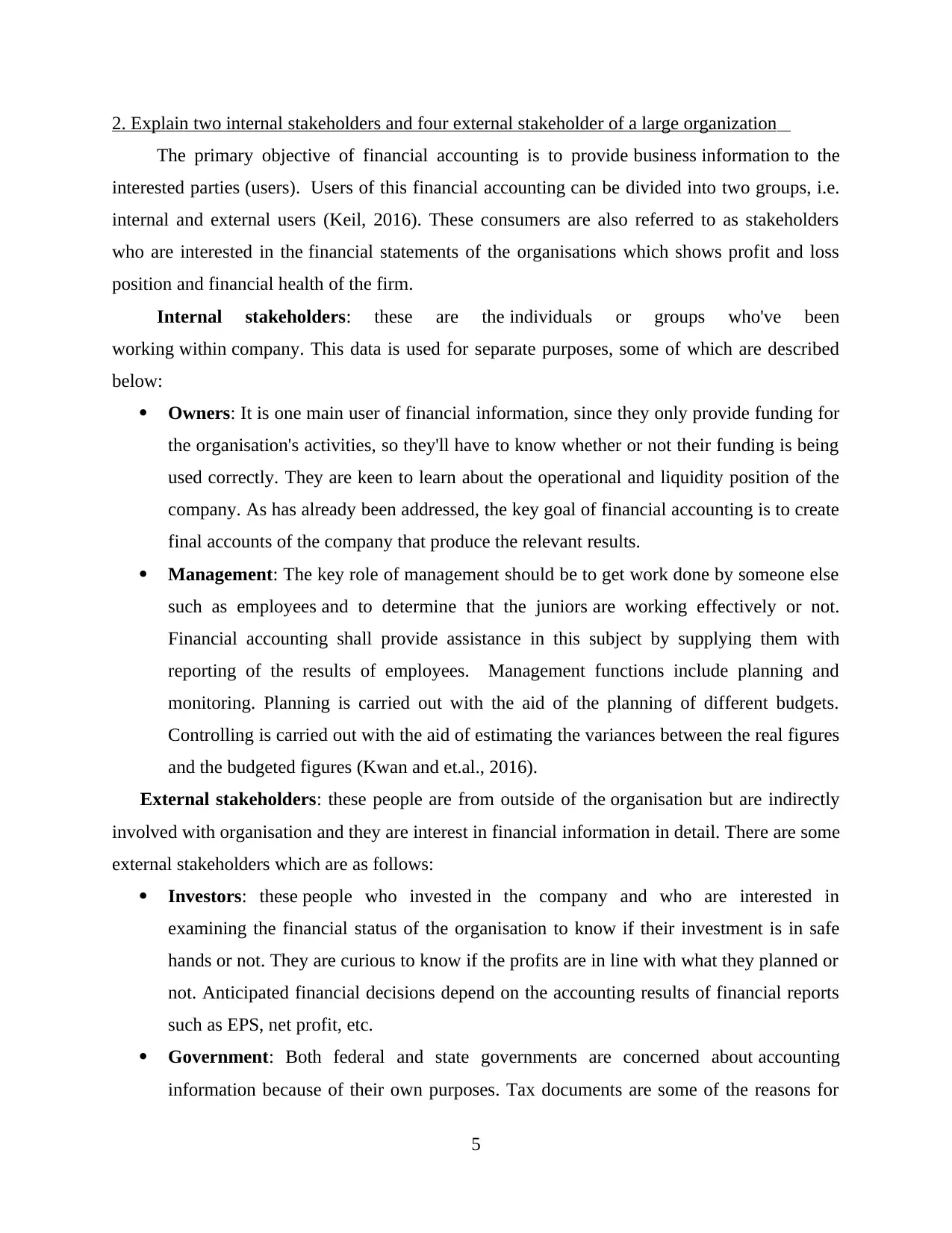
2. Explain two internal stakeholders and four external stakeholder of a large organization
The primary objective of financial accounting is to provide business information to the
interested parties (users). Users of this financial accounting can be divided into two groups, i.e.
internal and external users (Keil, 2016). These consumers are also referred to as stakeholders
who are interested in the financial statements of the organisations which shows profit and loss
position and financial health of the firm.
Internal stakeholders: these are the individuals or groups who've been
working within company. This data is used for separate purposes, some of which are described
below:
Owners: It is one main user of financial information, since they only provide funding for
the organisation's activities, so they'll have to know whether or not their funding is being
used correctly. They are keen to learn about the operational and liquidity position of the
company. As has already been addressed, the key goal of financial accounting is to create
final accounts of the company that produce the relevant results.
Management: The key role of management should be to get work done by someone else
such as employees and to determine that the juniors are working effectively or not.
Financial accounting shall provide assistance in this subject by supplying them with
reporting of the results of employees. Management functions include planning and
monitoring. Planning is carried out with the aid of the planning of different budgets.
Controlling is carried out with the aid of estimating the variances between the real figures
and the budgeted figures (Kwan and et.al., 2016).
External stakeholders: these people are from outside of the organisation but are indirectly
involved with organisation and they are interest in financial information in detail. There are some
external stakeholders which are as follows:
Investors: these people who invested in the company and who are interested in
examining the financial status of the organisation to know if their investment is in safe
hands or not. They are curious to know if the profits are in line with what they planned or
not. Anticipated financial decisions depend on the accounting results of financial reports
such as EPS, net profit, etc.
Government: Both federal and state governments are concerned about accounting
information because of their own purposes. Tax documents are some of the reasons for
5
The primary objective of financial accounting is to provide business information to the
interested parties (users). Users of this financial accounting can be divided into two groups, i.e.
internal and external users (Keil, 2016). These consumers are also referred to as stakeholders
who are interested in the financial statements of the organisations which shows profit and loss
position and financial health of the firm.
Internal stakeholders: these are the individuals or groups who've been
working within company. This data is used for separate purposes, some of which are described
below:
Owners: It is one main user of financial information, since they only provide funding for
the organisation's activities, so they'll have to know whether or not their funding is being
used correctly. They are keen to learn about the operational and liquidity position of the
company. As has already been addressed, the key goal of financial accounting is to create
final accounts of the company that produce the relevant results.
Management: The key role of management should be to get work done by someone else
such as employees and to determine that the juniors are working effectively or not.
Financial accounting shall provide assistance in this subject by supplying them with
reporting of the results of employees. Management functions include planning and
monitoring. Planning is carried out with the aid of the planning of different budgets.
Controlling is carried out with the aid of estimating the variances between the real figures
and the budgeted figures (Kwan and et.al., 2016).
External stakeholders: these people are from outside of the organisation but are indirectly
involved with organisation and they are interest in financial information in detail. There are some
external stakeholders which are as follows:
Investors: these people who invested in the company and who are interested in
examining the financial status of the organisation to know if their investment is in safe
hands or not. They are curious to know if the profits are in line with what they planned or
not. Anticipated financial decisions depend on the accounting results of financial reports
such as EPS, net profit, etc.
Government: Both federal and state governments are concerned about accounting
information because of their own purposes. Tax documents are some of the reasons for
5
⊘ This is a preview!⊘
Do you want full access?
Subscribe today to unlock all pages.

Trusted by 1+ million students worldwide

interest. They will need financial information on the basis of the collection of business-
related statistics used to compile national accounts.
Creditors: Company owes some funds to certain parties such as suppliers who provide
raw material, money lending etc. They are concerned in accounting details on the
grounds that they'd like to maintain the financial health of the company (Mook and et.al.,
2015). If previous estimates and audits are not carried out by creditors, they which
contribute to their bad debts, as the business does not occupy the role in which it will be
sufficient to reimburse debts.
Society: Community as a whole needs to check the company's financial details, so it
needed to understand whether or not the company fulfils its obligation towards society
for example CSR. It will be an effective tool for maintaining a good place between
society and target audience.
6
related statistics used to compile national accounts.
Creditors: Company owes some funds to certain parties such as suppliers who provide
raw material, money lending etc. They are concerned in accounting details on the
grounds that they'd like to maintain the financial health of the company (Mook and et.al.,
2015). If previous estimates and audits are not carried out by creditors, they which
contribute to their bad debts, as the business does not occupy the role in which it will be
sufficient to reimburse debts.
Society: Community as a whole needs to check the company's financial details, so it
needed to understand whether or not the company fulfils its obligation towards society
for example CSR. It will be an effective tool for maintaining a good place between
society and target audience.
6
Paraphrase This Document
Need a fresh take? Get an instant paraphrase of this document with our AI Paraphraser
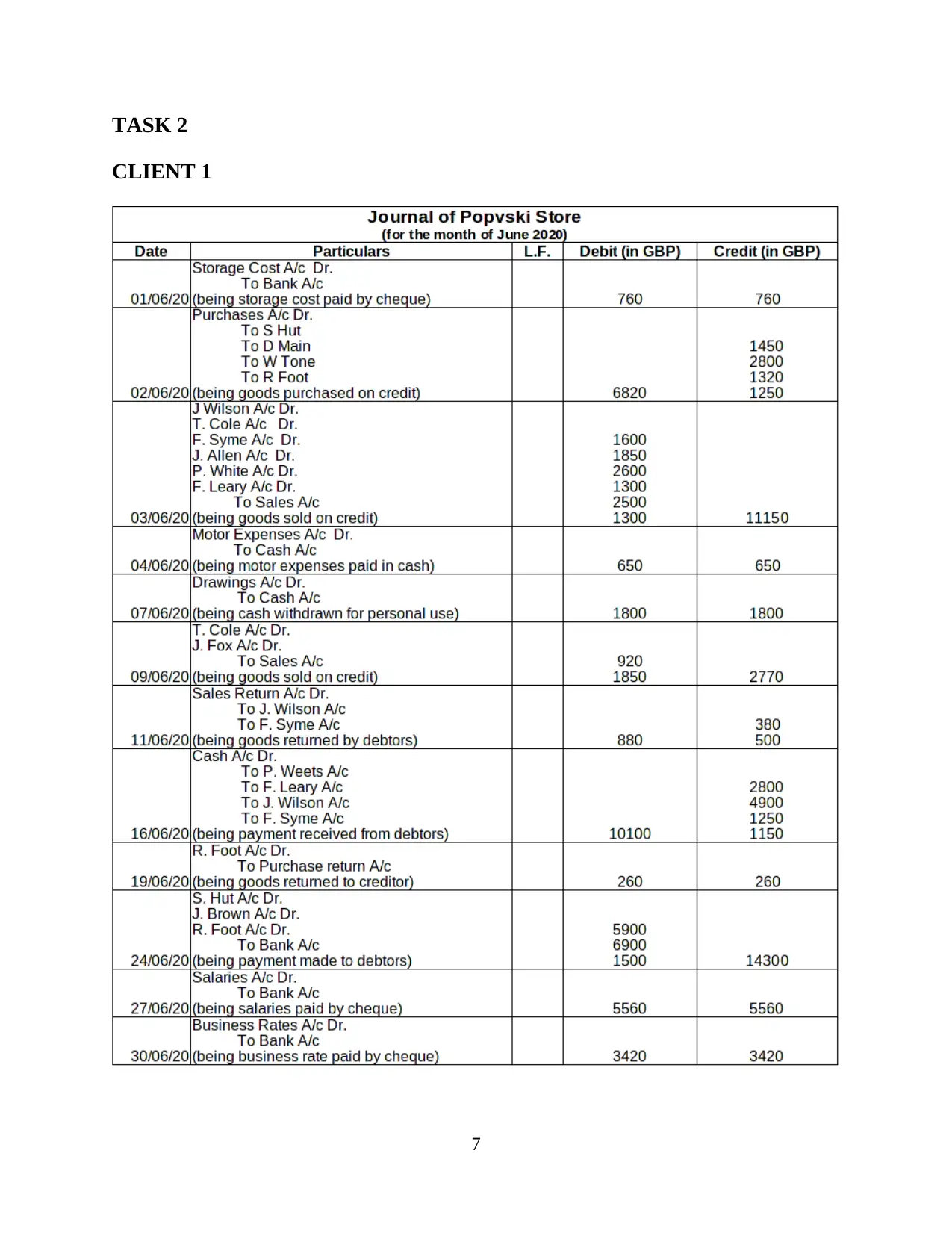
TASK 2
CLIENT 1
7
CLIENT 1
7
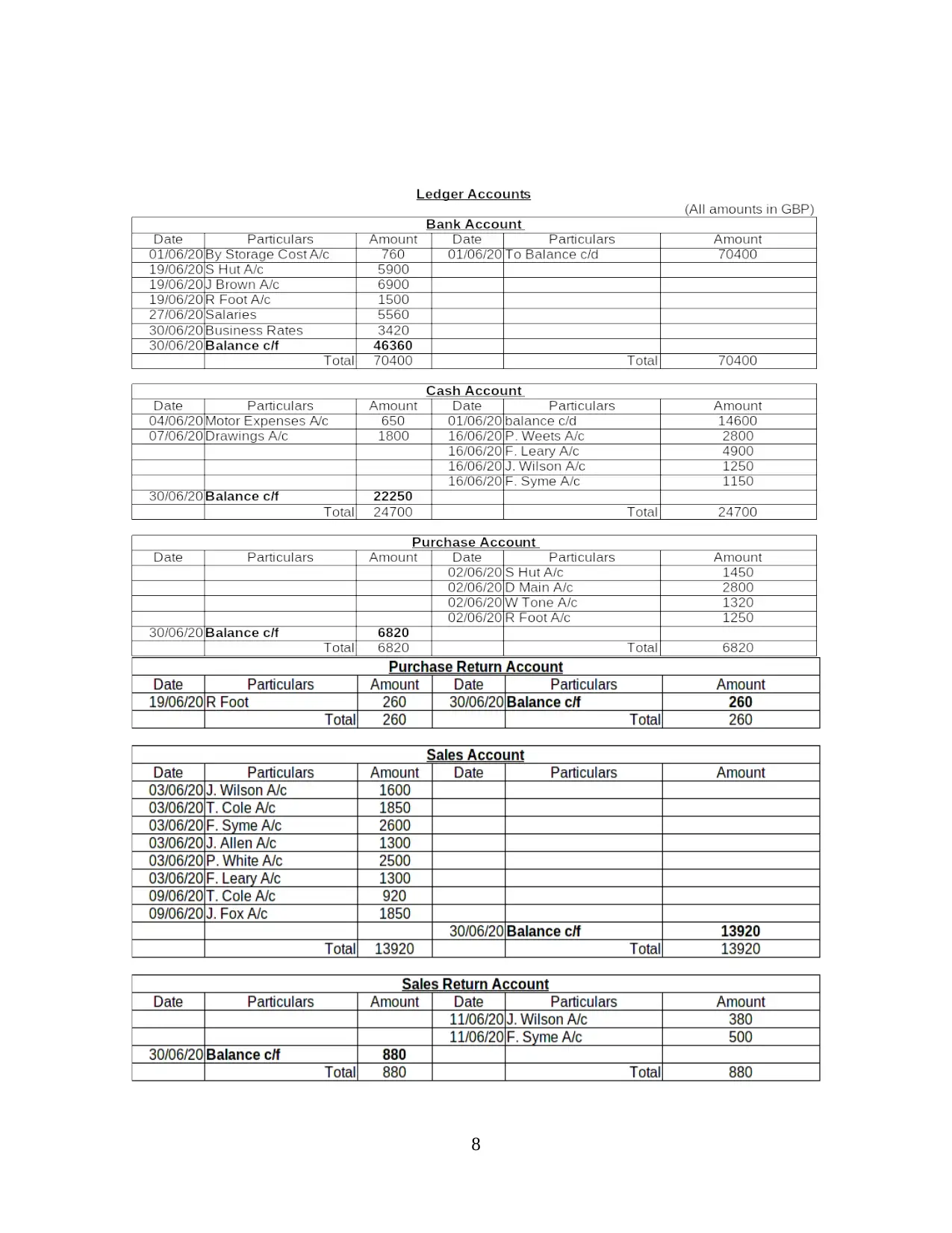
8
⊘ This is a preview!⊘
Do you want full access?
Subscribe today to unlock all pages.

Trusted by 1+ million students worldwide

9
Paraphrase This Document
Need a fresh take? Get an instant paraphrase of this document with our AI Paraphraser
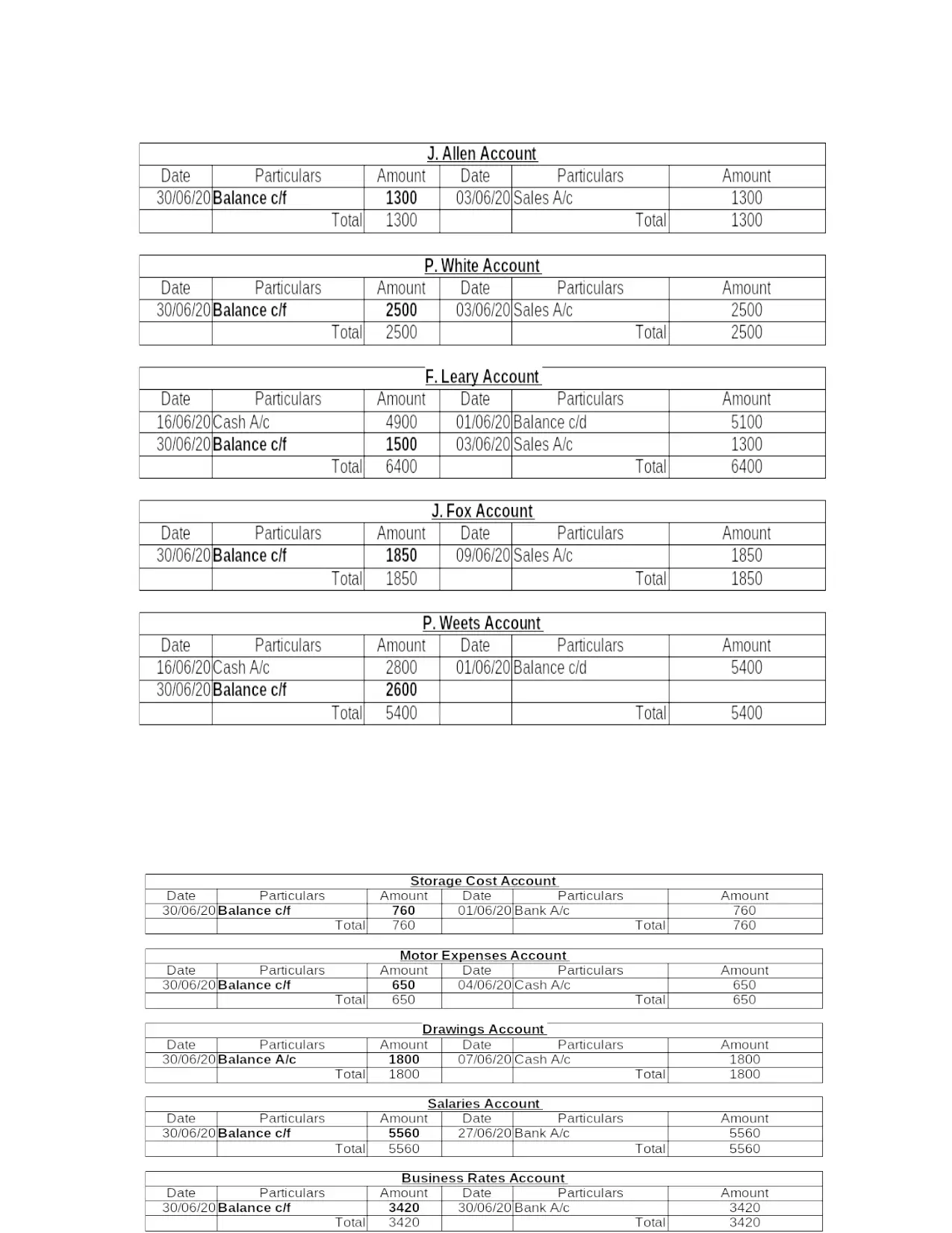
10
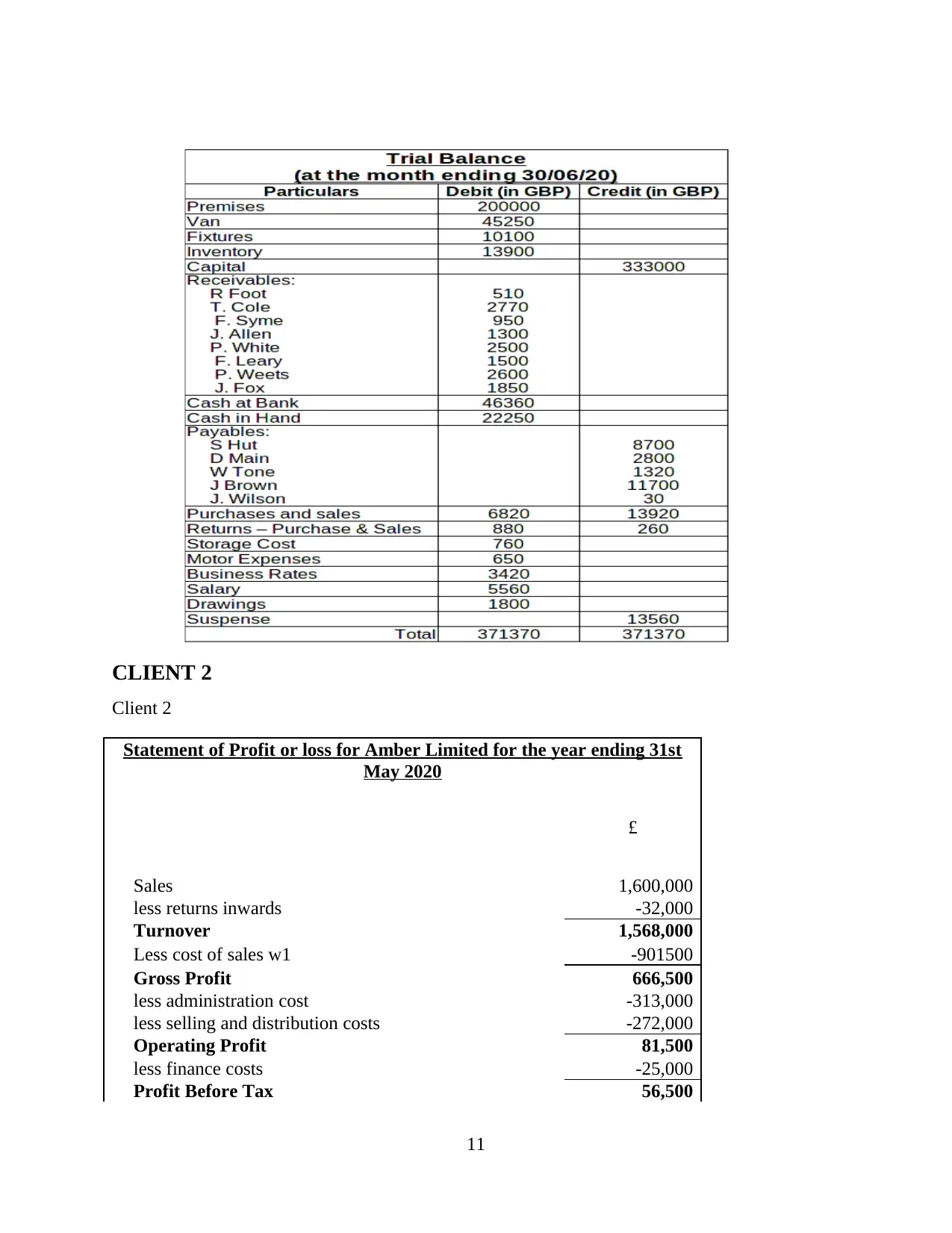
CLIENT 2
Client 2
Statement of Profit or loss for Amber Limited for the year ending 31st
May 2020
£
Sales 1,600,000
less returns inwards -32,000
Turnover 1,568,000
Less cost of sales w1 -901500
Gross Profit 666,500
less administration cost -313,000
less selling and distribution costs -272,000
Operating Profit 81,500
less finance costs -25,000
Profit Before Tax 56,500
11
Client 2
Statement of Profit or loss for Amber Limited for the year ending 31st
May 2020
£
Sales 1,600,000
less returns inwards -32,000
Turnover 1,568,000
Less cost of sales w1 -901500
Gross Profit 666,500
less administration cost -313,000
less selling and distribution costs -272,000
Operating Profit 81,500
less finance costs -25,000
Profit Before Tax 56,500
11
⊘ This is a preview!⊘
Do you want full access?
Subscribe today to unlock all pages.

Trusted by 1+ million students worldwide
1 out of 22
Related Documents
Your All-in-One AI-Powered Toolkit for Academic Success.
+13062052269
info@desklib.com
Available 24*7 on WhatsApp / Email
![[object Object]](/_next/static/media/star-bottom.7253800d.svg)
Unlock your academic potential
Copyright © 2020–2025 A2Z Services. All Rights Reserved. Developed and managed by ZUCOL.





